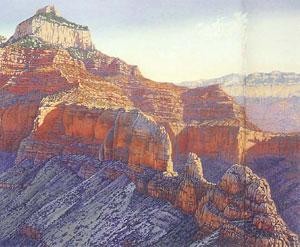Bruce Aiken had a unique experience in his life: he lived at the Grand Canyon. The Wildcat caught up with Mr. Aiken to gain some insight into his life and motives while living at one of the Seven Wonders of the World. Students can hear more about his experiences today at the UofA Bookstore, where he will have a book signing, lecture and slide show about his book “”The Grand Canyon Captured””, from 4:30-6 p.m.
W: How exactly do you make your living?
A: I have been selling art across the face of the planet since the ’70s. I’ve sold in art galleries; I’ve been in shows, exhibits. I’ve done stock work, put paintings out there on the market. I’ve done everything that an artist can do to make a living. I’m thoroughly steeped in an art background.
W: How did you school your children while living at the Grand Canyon?
A: We did home schooling at first and we taught our kids up through mostly grade school and then they all graduated from Grand Canyon High School, which is in Grand Canyon Village. But they did get a lot of home schooling down in the canyon over the years. My wife did most of that.
W: Did you ever get lonely living at the Grand Canyon?
A: No, not at all. There was nothing to be lonely about in the canyon. There’s so much going on down there – we were so tuned into nature. Nature was our friend. We’d walk out our front door and it was straight up cliffs, thousands and thousands of feet into the air. Nothing was man-made. It was all about nature. You never get tired of that.
W: Did you need special permission from the state of Arizona to live at the Grand Canyon since it is a national park?
A: No. It’s a national park so you have to understand that the federal government is responsible for this, not the state of Arizona. I had a part-time job with the National Park Service so that was how I pulled it off.
W: Why did you decide to live at the Grand Canyon?
A: It is the most dynamic thing on the planet. There’s nothing else that even remotely looks like it. It’s nature out of control. Man can’t do anything about it. It’s powerful and I was looking for something that had that kind of power. As a young artist I was looking for these type elements, strength, dynamics and a clean environment. I was living in New York City in the late ’60s, studying painting and my painting led me to the Grand Canyon looking for a natural subject.
W: With the park service job were you able to completely provide for your family?
A: That provided some for my family but I was trying to make a living as an artist so I just kept pushing along the road of creating better and better art and pretty soon I had two ways to make a living.
W: What did your family think of living there?
A: They absolutely loved it. My kids had the most amazing upbringing and they know it. They know what they had was more unique than anybody else ever could have hoped for.
W: What is one of the weirdest things that ever happened to you while you were living in the Grand Canyon? Have you had strange run-ins with wildlife?
A: Probably the weirdest thing I ever saw was this guy carrying the entire set of the Encyclopaedia Britannica across the canyon. I had a long conversation about it with him. Basically he was running for president. I had a skunk in my bedroom closet; I’ve had run-ins but I’d rather have a run-in with wildlife than with a crazy person. Wildlife is way better.
W: What is your favorite thing about the Grand Canyon?
A: That it’s so big it’s out of control.
W: Why should people read your book?
A: It will give them an uplifting day. It will give them hope.
W: Anything you’d like to add?
A: I want to give a piece of advice to all the students at the UA. You will not achieve as much as you could unless you take risks. You must take risks at this life and you must seize your opportunities. Whenever an opportunity arises you must examine it carefully because that opportunity will be gone and will never come back. It’s not failure that’s a crime, but low aim.









